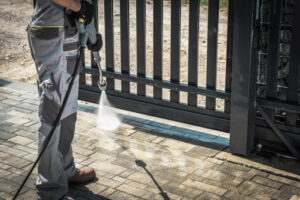 Downstreaming pressure washing is a powerful and effective way of cleaning surfaces that are difficult to reach with a standard pressure washer. It is an innovative technique that uses the power of high-pressure water jets to remove dirt, grime and other debris from hard-to-reach places. In this article we will discuss what downstreaming pressure washing is, how it works and the many benefits it provides.
Downstreaming pressure washing is a powerful and effective way of cleaning surfaces that are difficult to reach with a standard pressure washer. It is an innovative technique that uses the power of high-pressure water jets to remove dirt, grime and other debris from hard-to-reach places. In this article we will discuss what downstreaming pressure washing is, how it works and the many benefits it provides.
The first thing to know about downstreaming pressure washing is that it utilises high-pressure water jets to clean surfaces. This means that the force of the water jets can be controlled with precision, making it an ideal solution for cleaning surfaces that are difficult to reach with other methods such as scrubbing or brushing. Not only does downstreaming pressure washing provide a deep clean, but it also helps protect surfaces from damage caused by dirt and debris buildup.
In addition to providing an effective solution for hard-to-reach areas, downstreaming pressure washing has a number of other advantages. This includes being able to quickly and efficiently remove stubborn stains and discoloration, reducing water usage and conserving energy. It also helps protect delicate surfaces such as stone or wood from damage due to its precise nature. Finally, it can help reduce labor costs since less time is needed for cleaning than with more traditional methods.
By understanding what downstreaming pressure washing is and how it works, you can make informed decisions about which techniques are best suited for your needs when it comes to surface cleaning and maintenance. In this article we will explore all these aspects in greater detail so you can make a well informed decision on whether this type of pressure washing is right for you!
What Is Downstreaming Pressure Washing?
Downstreaming pressure washing is a method of cleaning surfaces using a pressure washer. It involves the use of high-pressure water to break away dirt, grime, and other build-up from surfaces. Pressure washers are powerful tools that can reach areas difficult to clean by hand.
A pressure washer consists of a pump, hose, and nozzle. The pump forces the water through the hose and out the nozzle at a high pressure. The force of the water is what allows it to break away dirt and debris from surfaces. When downstreaming, the pump is set up in such a way that it directs the water through an additional hose with an attached nozzle before it reaches its target surface. This allows for greater control over the direction and distance of the spray and increases safety as it reduces any potential risk of kickback from the surface being cleaned.
Downstreaming with a pressure washer is one of many ways to clean surfaces quickly and effectively. By properly setting up your equipment you can make sure you get maximum results while also ensuring safety for yourself and those around you during operation.
Benefits Of Downstreaming Pressure Washing
Downstreaming pressure washing offers many benefits over traditional methods of cleaning. It is a fast, efficient and cost-effective way to remove dirt, grime and other build-up from surfaces. The use of high-pressure water means that it is able to break away dirt and debris quickly, without the need for harsh chemicals or manual scrubbing. Additionally, the ability to direct the water at a specific angle and distance allows for greater precision when cleaning hard-to-reach areas.
Safety is also a major benefit of downstreaming with a pressure washer. By directing the water through an additional hose, it reduces any potential risk of kickback from the surface being cleaned. This helps protect not only you but also those around during operation. Furthermore, using a pressure washer means that you won’t have to worry about using harsh chemicals on your surfaces as they are not usually necessary when using this method of cleaning.
Overall, downstreaming with a pressure washer is an effective and safe way to clean surfaces quickly and effectively. With proper setup and operation, you can be sure that your results will be top notch while also keeping yourself and those around you safe during use.
What Equipment Is Needed For Downstreaming Pressure Washing?
Downstreaming pressure washing is a convenient and effective way to quickly clean surfaces, but it does require some special equipment. To get the most out of your pressure washer and ensure safe operation, it’s important to understand what you’ll need to purchase or rent in order to get started.
First, a pressure washer with downstreaming capabilities is essential for any cleaning job. It should have enough power for the job at hand as well as contain all of the necessary fittings and hoses for downstreaming. It’s also important to make sure the pressure washer has an adjustable nozzle that can be used to direct the water at specific angles and distances, as this will give you greater precision when cleaning hard-to-reach areas.
In addition to a pressure washer, you may also need additional nozzles and attachments such as turbo nozzles and rotary nozzles for more intricate jobs. You may also want to invest in protective gloves and safety glasses if you are planning on doing any heavy-duty cleaning. Finally, don’t forget to pick up some detergent or other cleaning agents that are designed specifically for use with a pressure washer – these will make your job much easier!
With all of these items in place, you’ll be ready to start downstreaming with your pressure washer and enjoy all of its benefits!
How Does Downstreaming Pressure Washing Work?
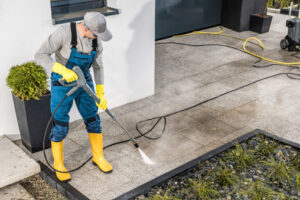 Now that you’ve got the right equipment, it’s time to understand the process of downstreaming pressure washing. This type of cleaning utilizes a special nozzle that directs water at an angle away from the surface being cleaned, allowing it to reach debris and buildup in hard-to-reach places. This means that you can clean around corners, under decks, and other difficult spots with ease!
Now that you’ve got the right equipment, it’s time to understand the process of downstreaming pressure washing. This type of cleaning utilizes a special nozzle that directs water at an angle away from the surface being cleaned, allowing it to reach debris and buildup in hard-to-reach places. This means that you can clean around corners, under decks, and other difficult spots with ease!
The key to successful downstreaming is having a good understanding of the pressure washer’s capabilities. The higher the pressure setting, the greater the distance between the nozzle and the surface being cleaned. However, if you use too much pressure, you risk damaging surfaces or blowing away delicate materials like shingles or siding. To prevent this from happening, always start with a low pressure setting and gradually increase it as needed.
When using downstreaming cleaning techniques, it’s important to take safety precautions such as wearing protective eye gear and gloves. You also need to be aware of your surroundings and make sure that no one is standing near you in case any debris or water splashes back in your direction. Once all safety measures are taken care of, you can begin cleaning with confidence!
Choosing The Right Nozzle For The Job
To ensure the best downstreaming pressure washing results, it’s important to choose the right nozzle for the job. Generally speaking, nozzles come in three different shapes: fan, pencil, and 0-degree. Fan nozzles disperse water into a wide, fan-shaped spray and are great for cleaning large surfaces like decks and driveways. Pencil nozzles focus water into a narrow stream that can be used to tackle stubborn dirt and grime in tight spots. Finally, 0-degree nozzles produce a powerful jet of water that’s best used on heavy buildup like mud or mildew.
When selecting a nozzle for downstreaming pressure washing, it’s important to consider its size as well as its shape. Nozzle sizes are measured in degrees and range from 0 (producing the most powerful spray) to 45 (which produces a wider but less powerful spray). To get the best results, choose a nozzle size that is appropriate for the type of surface you are cleaning and the amount of debris you need to remove.
Finally, make sure you have all of your safety gear ready before starting any project with a pressure washer. This includes eye protection such as goggles or glasses, gloves to protect your hands from any flying debris or chemical splashes, and sturdy shoes to keep you safe while working on slippery surfaces. With these precautions taken care of, you can rest assured that your downstreaming project will go off without a hitch!
Safety Tips For Performing Downstreaming Pressure Washing
Now that you’ve chosen the right nozzle for your downstreaming pressure washing project, it’s time to make sure you’re taking all the necessary safety precautions. Before beginning, be sure to double-check that all power cords and hoses are properly connected and secure. Also, make sure to keep the washer at least three feet away from any electrical outlets or appliances. Additionally, wear protective eyewear, gloves, and shoes whenever operating a pressure washer—especially when working near others.
When actually performing downstreaming pressure washing, never point the spray gun towards yourself or anyone else. Additionally, avoid pointing it towards windows, animals, or plants as this could cause damage to them. If you need to move in close proximity to the area being washed, be sure to turn off the machine first and wait until it is completely powered off before moving closer than three feet away from the nozzle. Lastly, always use a low-pressure setting when cleaning delicate surfaces like decks or siding. This will ensure that they don’t become damaged by the powerful water stream.
Following these safety tips will help ensure that your downstreaming pressure washing project is completed safely and successfully!
Common Mistakes To Avoid With Downstreaming Pressure Washing
Downstreaming pressure washing is a powerful tool, but it can also be dangerous if not used correctly. To ensure the best results and prevent any damage to your property or equipment, here are some common mistakes to avoid when performing downstreaming pressure washing:
First, never use too much pressure. It’s easy to think that more power equals better results, but this isn’t always the case. Too much pressure can damage surfaces like wood or vinyl siding and cause them to become weak or break apart. Additionally, it can remove paint from surfaces that you don’t want stripped down. Instead, try using a lower setting and work your way up—only increasing the pressure if necessary.
Second, avoid pointing the nozzle directly at windows or other delicate materials like shingles. Even though this method may seem effective in removing dirt and debris, it can cause serious damage to these sensitive areas. Try using a fan-shaped spray pattern instead as this will provide enough coverage while avoiding putting too much force on one concentrated area.
Lastly, never leave the machine unattended while it’s running. If you need to take a break for any reason, turn off the machine first and wait until it is completely powered off before moving away from it. Doing so will help prevent any potential accidents or damage from occurring while you are gone.
By following these tips and keeping an eye out for potential hazards, you’ll be able to complete your downstreaming pressure washing project safely and efficiently!
Troubleshooting Problems With Downstreaming Pressure Washing Systems
Despite the many benefits of downstreaming pressure washing, there may be times when it doesn’t work as expected. Troubleshooting these issues will help ensure that you get the best performance out of your system. Here are some common problems and solutions to consider when dealing with downstreaming pressure washing systems.
One issue is clogged nozzles, which can restrict water flow and reduce the effectiveness of your system. To avoid this, check for blockages on a regular basis and clean them out if necessary. If you notice any buildup, replace the nozzle with a new one to ensure optimal performance. In addition, make sure that all hoses are securely connected and free from any kinks or bends in order to maintain an even flow of water throughout your system.
Another common problem is low water pressure output from the hose or pump itself. This could be caused by worn-out or damaged parts, or simply due to improper maintenance of the system. Check all valves, filters, and other components to make sure they are functioning properly, then adjust their settings accordingly. If the issue persists after doing this, contact a professional for further assistance in troubleshooting your downstreaming pressure washing system.
In order to maximize its effectiveness, it’s important to keep your downstreaming pressure washing system in good condition and address any problems as soon as they arise. Taking preventive measures will help extend its lifespan and ensure consistent quality results with each use!
Different Types Of Materials Suitable For Downstreaming Pressure Washing
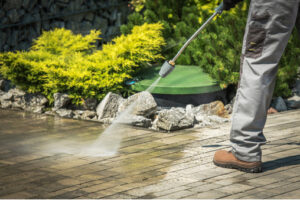 Downstreaming pressure washing is a great way to increase productivity, reduce costs, and ensure quality results. But how do you know which materials are suitable for this type of cleaning? The answer depends on the type of surface you’re trying to clean and the pressure washer’s capabilities.
Downstreaming pressure washing is a great way to increase productivity, reduce costs, and ensure quality results. But how do you know which materials are suitable for this type of cleaning? The answer depends on the type of surface you’re trying to clean and the pressure washer’s capabilities.
Generally speaking, downstreaming pressure washing is most effective on flat surfaces, such as driveways, decks and patios. This is because it uses less water than other methods and still provides a powerful cleaning action. It is also suitable for cleaning vertical surfaces like walls and fences since it can provide a more consistent coverage than traditional methods.
Additionally, downstreaming pressure washing can be used for a variety of materials including wood, brick, concrete and even metal. Be sure to check your equipment’s instructions before starting any project to ensure that you are using the correct settings for the material you are cleaning. With proper care and maintenance, your pressure washer should provide years of reliable service with fast and efficient results!
Advantages And Disadvantages Of Using A Hot Water System Vs Cold Water System
When it comes to downstreaming pressure washing, there are two main systems that can be used: hot water and cold water. Each has its own set of advantages and disadvantages that should be taken into consideration before choosing which one is the best for your specific project.
One of the key benefits of using a hot water system is that it can provide more power and better results than a cold water system. This is because hot water will break down dirt, grime, and debris much more quickly than cold water will. Additionally, hot water systems are known to use less energy, making them more cost-efficient. Finally, they can also reduce the risk of mold growth by killing off any bacteria or germs present on surfaces.
On the other hand, some people prefer to use a cold water system due to its lower cost and gentler cleaning action. Cold water systems are also safer to use around delicate materials like wood and painted surfaces since they don’t cause as much damage or discoloration. However, they tend to take longer to clean since the colder temperatures won’t break down debris as quickly as hot temperatures do.
Ultimately, when deciding between using a hot or cold water system for downstreaming pressure washing, you’ll need to consider your budget, the type of material you’re working with, and how quickly you need the job done in order to make an informed decision.
The Role Of Clean Agents In Downstreaming Pressure Washing Systems
In downstreaming pressure washing systems, clean agents play an important role. Clean agents are chemical agents that are added to the water in order to enhance its cleaning properties. They can help break down dirt particles and make it easier to remove them from surfaces or objects. There are several types of clean agents available, each with their own advantages and disadvantages.
The first type of clean agent is detergents, which are non-toxic and don’t require a significant amount of rinsing after use. This type of agent is particularly useful when cleaning delicate materials like wood or painted surfaces since they won’t cause any discoloration or damage. However, detergents are not as effective at breaking down heavy dirt and grime as other types of agents.
Another type of clean agent is solvents, which work by dissolving oils, grease, and other substances that may be present on surfaces. These agents tend to be more effective than detergents at removing heavy dirt and grime but can also be more damaging to some materials if used improperly. Additionally, solvents must be thoroughly rinsed off after use in order to avoid any unwanted residue being left behind.
Overall, the choice between detergents and solvents should depend on the type of material being cleaned as well as the level of dirt present on the surface. In any case, adding a clean agent to your downstreaming pressure washing system can greatly improve its effectiveness in removing dirt and debris from surfaces quickly and effectively.
Best Practices For Clean Up After A Downstreaming Pressure Wash
Now that you know the importance of using clean agents in a downstreaming pressure washing system, it’s important to understand how to properly clean up after the job. Proper cleanup is essential for making sure all dirt and debris has been removed and that no damage has been done to the surface being cleaned. Here are some of the best practices for clean up after a downstreaming pressure wash:
First, be sure to rinse off any surfaces with clean water after the pressure washing has been completed. This will help remove any residue from the cleaning agents used as well as any dirt or debris that may have been loosened during the process. If possible, use a garden hose with a high-pressure nozzle for this step; otherwise, use a soft-bristled brush and bucket of warm water.
Second, inspect all surfaces carefully to make sure they are free from dirt, grime, and other contaminants. If any areas appear to have been missed or not thoroughly cleaned, repeat the pressure washing process until you are satisfied with the results. It is also important to make sure all parts of your downstreaming pressure washer are properly lubricated and in good working order before you put it away.
Finally, take steps to protect surfaces from future dirt buildup by applying a sealant or protective coating if necessary. This will help keep surfaces looking great while also extending their lifespan by preventing further damage from occurring down the road.
Cost Comparison Between Different Types Of Downstreaming Equipment
When deciding what type of downstreaming equipment to invest in, cost is often a major factor. There are a variety of types of downstreaming equipment on the market, each with their own pros and cons related to cost. This article will look at the different types of downstreaming equipment available and compare them in terms of price.
First up is rental pressure washers. These are the most affordable option when it comes to downstreaming equipment, as they can be rented from local home improvement stores or online for a fraction of the cost of purchasing one outright. However, you won’t get all the features that come with more expensive models and may need to purchase additional attachments separately.
Another common type of downstreaming equipment is hot water pressure washers. Hot water pressure washers provide superior cleaning power compared to cold water options, so they tend to be more expensive upfront but can save time and money in the long run. They also require more maintenance than cold water washers due to their higher operating temperatures, so it’s important to factor that into your decision when weighing your options.
Finally, there are also specialty pressure washers designed for specific tasks such as steam cleaning or chemical spraying. These machines tend to be pricier than other options due to their specialized capabilities, but they can really improve efficiency when tackling tough jobs that require specific tools or chemicals.
Sustainability Considerations When Choosing A Downstreaming System
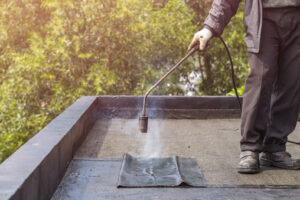 Sustainability is an important consideration when choosing a downstreaming system. There are several ways that pressure washers can be used in an environmentally responsible manner. First, it’s important to look for a model that has adjustable water pressure settings so that you can reduce the amount of water used for cleaning. Additionally, many hot water pressure washers are designed to capture and reuse the heated water from their cleaning process, which can help save energy and resources.
Sustainability is an important consideration when choosing a downstreaming system. There are several ways that pressure washers can be used in an environmentally responsible manner. First, it’s important to look for a model that has adjustable water pressure settings so that you can reduce the amount of water used for cleaning. Additionally, many hot water pressure washers are designed to capture and reuse the heated water from their cleaning process, which can help save energy and resources.
Another way to ensure your downstreaming equipment is being used responsibly is by opting for electric models rather than gas-powered ones. Electric models are more efficient and don’t produce any emissions or exhaust fumes, making them better for the environment. They also tend to be quieter than gas-powered models, so they won’t disturb neighbors or passersby while in use.
Finally, it’s important to be aware of any local regulations or restrictions regarding the use of pressure washers in certain areas. Many cities and towns have rules about noise levels and runoff from pressure washing activities, so it’s best to research these beforehand to make sure you don’t run into any issues down the line. By following these guidelines, you can rest assured knowing your downstreaming system is being used responsibly and sustainably.
Professional Tips And Advice On Selecting The Right System
When selecting the right downstreaming system, it’s important to take into account a few key factors. First, consider the type of cleaning job you’ll be doing and the surface you’ll be working on; this will help determine which type of pressure washer to opt for – either electric or gas-powered. Additionally, it’s important to think about the size of surface area you need to cover as well as any other specific requirements for your project.
It’s also wise to research any local regulations or restrictions that may apply when using pressure washers in certain areas. Check with your local government for more information about any noise levels or runoff requirements that must be followed in order to operate legally and safely.
Finally, if possible, consult with an experienced professional who can provide tips and advice on selecting the right system for your needs. An expert can offer valuable insight on which models are best suited for specific jobs and point out any potential issues that may arise when using certain types of pressure washers. Taking these considerations into account will help ensure you select a downstreaming system that meets all your needs efficiently and sustainably.
Conclusion
Downstreaming pressure washing is a great way to clean surfaces quickly and efficiently without the use of harsh chemicals. The combination of high pressure, heat, and water allows for a deeper clean with minimal effort. Before using downstreaming pressure washing, it’s important to research the various types of equipment available and choose the right nozzle for the job. When cleaning up after downstreaming, it’s best to avoid runoff and dispose of wastewater responsibly. Lastly, be sure to consider sustainability factors when selecting a downstreaming system. With careful consideration, you can make sure that your downstreaming pressure washer will be able to meet your needs while still being environmentally friendly.
Overall, downstreaming pressure washing is an effective way to keep surfaces clean without the use of harsh chemicals or excessive water consumption. It’s important to consider all factors before making a decision on which system to purchase. From selecting the right nozzle to disposing of wastewater properly, there are many things that need to be taken into account in order to get the most out of your downstreaming system while still being mindful of environmental impact. With careful planning and research you can find the perfect solution for your cleaning needs while still doing your part for the environment!
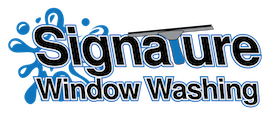
Recent Comments